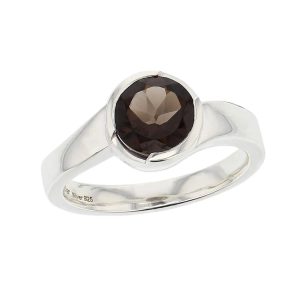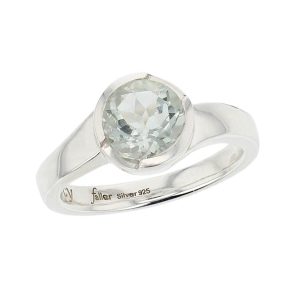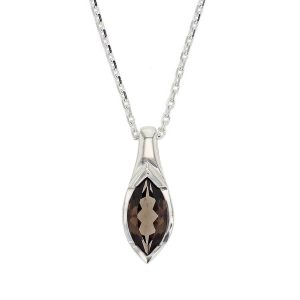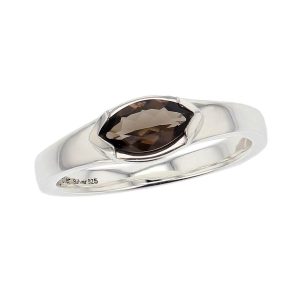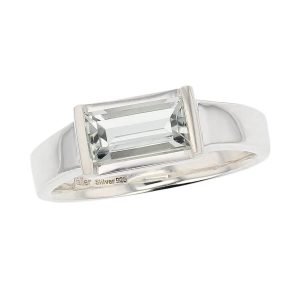-
About Quartz
Quartz is the chemical compound, silicon dioxide or silica. It is the second most abundant mineral in Earth’s continental crust, a component in granite, sandstone, schist and shale to name a few.
Many forms of quartz are used as gemstones and they are all affordable. They are cut into various gemstone cuts and cabochons, and used in all forms of jewelry. The wide range of colour, lack of cleavage and good durability and wide availability combine to make quartz is a very popular semi-precious gemstone option.
Gemstone varieties are divided into two main groups:
- Varieties that develop visible crystals or are made of large inter-grown crystals. They tend to be transparent to translucent and include Amethyst, Citrine, Smoky quartz, Rose quartz, Green quartz and Rutilated quartz.
- Microcrystalline or cryptocrystalline quartz are varities composed of tiny crystals that cannot be seen with an unaided eye. Known as Chalcedony they tend to be translucent to opaque and include multi-coloured Agate, Adventurine, Jasper, Carnelian, Chrysoprase, Onyx, Tiger’s Eye and Bloodstone.
- Varieties that develop visible crystals or are made of large inter-grown crystals. They tend to be transparent to translucent and include Amethyst, Citrine, Smoky quartz, Rose quartz, Green quartz and Rutilated quartz.
-
Green Quartz

Also known Prasiolite or Green Amethyst, this is a light green, transparent quartz. Almost all natural prasiolite comes from a small Brazilian mine, though it has also been discovered in Lower Silesia in Poland. It’s one of the rarest naturally occurring quartz. Most prasiolite in the market has been created by heat-treating amethyst. It is available in a wide range of faceted shapes and sizes.
Prasiolite is said to have a healing effect when you wear or carry it and helps to turn negative energy into positive energy. It is also believed to attract success, prosperity, and stimulate creativity.
-
Rose Quartz

Rose quartz is a pink variety of quartz crystal. It ranges in colour from very light pink to medium pink in intensity. It is translucent and often appears milky or hazy. Rose Quartz has good durability with a Moh’s scale hardness of 7 and a vitreous (glass-like) lustre. It forms as large inter-grown crystals and is mainly cut as smooth or faceted cabochons or beads for jewellery. It is also a popular stone for carving.
Rose quartz is commonly found in Brazil and Madagascar.
Rose Quartz is believed to attract love, encouraging romance and intimacy. It is thought to have been used as a love token from as early as 600 B.C.
Rose Quartz is also considered an important talisman for all relationships. It fosters forgiveness, reconciliation and empathy, and it is said to lower tension and stress in the heart, clear out resentment, jealousy and anger. To help rebuild trust and recommitment to an already existing relationship and closer bonds with family or friends.
-
Rutilated Quartz

Rutilated Quartz is transparent colourless quartz with golden yellow rutile needle-like inclusions. The rutile inclusions range from thin, sparse, and parallel, to thick, dense, and crisscrossed and each is unique in its pattern of rutile inclusions.
It is called the “Venus’s hair stone” after its fine golden hairs. Rutilated Quartz is an effective antidepressant because it heals emotional wounds. Mediation with this gem also increases intuition and improves clarity of thought. -
Smoky Quartz

Smoky Quartz or smokey quartz is the brown variety of quartz, ranging from light brownish-gray to nearly black. It can vary from almost completely transparent to nearly opaque. It has a hardness of 7 on the Mohs scale and is available in a wide range of faceted shapes and sizes.Smoky quartz has powerful healing properties for the body and soul. It is known to dispel negative energy, detoxify the body, protect from radiation and heal digestion issues. Smoky quartz can assist us in relieving the symptoms of depression, and anxiety. It promotes positive thinking and clarity of mind. It alleviates suicidal tendencies.

Quartz
Pure quartz, traditionally called rock crystal is colourless and transparent or translucent. The coloured varieties of quartz occur due to built-in trace elements or inclusions of other minerals.










